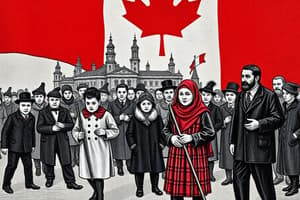Podcast
Questions and Answers
What was the primary method used by Canadian immigration officials to assess the race of potential immigrants before the climate clause was introduced?
What was the primary method used by Canadian immigration officials to assess the race of potential immigrants before the climate clause was introduced?
They contacted local American postmasters to inquire about the race of applicants.
What was implied by the 'climate clause' introduced in the Canadian immigration policy?
What was implied by the 'climate clause' introduced in the Canadian immigration policy?
It implied that individuals from tropical areas or the African continent were unsuitable for the climatic conditions of Canada.
How did the Canadian government financially benefit from the Chinese Immigration Act of 1885?
How did the Canadian government financially benefit from the Chinese Immigration Act of 1885?
The government imposed a head tax of $500 on Chinese immigrants, which generated revenue for projects like the Transcontinental Railroad.
What was the outcome of the Chinese Exclusion Act of 1923?
What was the outcome of the Chinese Exclusion Act of 1923?
What statement did Robert Borden’s immigration superintendent make regarding Black settlers in 1912?
What statement did Robert Borden’s immigration superintendent make regarding Black settlers in 1912?
What historical laws exemplify Canada's xenophobic attitudes towards immigrants?
What historical laws exemplify Canada's xenophobic attitudes towards immigrants?
According to recent studies, how do attitudes towards newer immigrants in Canada differ from those who arrived over 50 years ago?
According to recent studies, how do attitudes towards newer immigrants in Canada differ from those who arrived over 50 years ago?
What was the percentage increase in hate crimes against Muslims in Canada from 2015 to 2019?
What was the percentage increase in hate crimes against Muslims in Canada from 2015 to 2019?
Identify the groups of immigrants that Canadian immigration policies historically regarded as less desirable.
Identify the groups of immigrants that Canadian immigration policies historically regarded as less desirable.
What does the term 'open-door policy' refer to in the context of Canadian immigration history?
What does the term 'open-door policy' refer to in the context of Canadian immigration history?
Flashcards
Exclusionary Immigration Policies
Exclusionary Immigration Policies
A situation where a country has policies that exclude certain groups of people from immigrating based on their ethnicity, religion, or origin.
Assimilable Immigrants
Assimilable Immigrants
The belief that people from certain ethnicities or backgrounds are less desirable as immigrants and should be limited or excluded.
Canadian Identity Crisis
Canadian Identity Crisis
The idea that Canada's national identity is built on excluding certain immigrants and favoring others based on their perceived assimilability, despite its multicultural image.
Historical Xenophobia in Canada
Historical Xenophobia in Canada
Signup and view all the flashcards
Increasing Hate Crimes Against Muslims
Increasing Hate Crimes Against Muslims
Signup and view all the flashcards
Unofficial Barriers for Blacks (1869-1953)
Unofficial Barriers for Blacks (1869-1953)
Signup and view all the flashcards
The "Climate Clause"
The "Climate Clause"
Signup and view all the flashcards
Chinese Head Tax (1885-1923)
Chinese Head Tax (1885-1923)
Signup and view all the flashcards
Chinese Exclusion Act (1923)
Chinese Exclusion Act (1923)
Signup and view all the flashcards
Chinese Contribution to Canada's Infrastructure
Chinese Contribution to Canada's Infrastructure
Signup and view all the flashcards
Study Notes
Canadian Immigration History
- Xenophobia and exclusionary policies have been a feature of Canadian identity, despite claims of multiculturalism.
- Examples include discriminatory policies targeting Irish, Chinese, Sikhs, Jews, Japanese, and Haitians.
- A significant portion of Canadians hold negative views towards specific ethnic groups, particularly newer immigrants.
- Only 4% of Canadians hold negative views towards immigrants who arrived over 50 years ago compared to 10% for those who arrived in the last 15 years.
- Hate crimes against Muslims have risen dramatically, reaching a record high in 2020.
Early Immigration Policies (Post-Confederation)
- Canada developed independent immigration policies after Confederation.
- Initial policies focused on attracting settlers (British, Americans, Europeans, etc.)
- Preference was given to certain groups.
- Asians, Jews, Roma/Gypsies, and Black people were at the bottom of the list and distinguished differently.
Chinese Exclusion (1885-1947)
- Chinese immigration was heavily restricted as a federal policy.
- Head taxes were imposed to deter Chinese immigrants.
- The 1923 Chinese Exclusion Act severely limited immigration.
- This policy had negative impacts on Chinese communities, disrupting family life.
White and English Preference (1905-1947)
- Immigration policies prioritized white immigrants for the West and explicitly encouraged English speakers.
- Non-European immigrants were not given as favorable treatment.
- Canadian immigration authorities evaluated immigrants using factors like race, perceived work ethic, and the ability to contribute to the agricultural sector.
Post-1960s Shift
- Racial discrimination in immigration policies was largely eliminated in the 1960s.
- After this, immigration was based on individual merits rather than racial categories.
- Significant numbers of non-European immigrants began to arrive.
- Canada's increased diversity became apparent, leading to a multiracial society, unprecedented for previous generations.
Studying That Suits You
Use AI to generate personalized quizzes and flashcards to suit your learning preferences.




